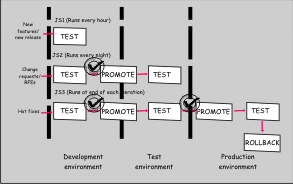Streamline release management - a business scenario
Deploy new products, features, and fixes faster.
If you can reduce the amount of time it takes to push a code change into production, then you also reduce costs and maximize productivity, efficiency, and reliability. Code changes are usually triggered by a new feature or release, a minor enhancement stemming from a change request, or an emergency situation where a hot fix needs to be implemented.
Code changes also need to be continuously tested, integrated and built, and they often need to undergo an approval process before they can be promoted. To deliver business value, your release management process cannot suffer lag time from manual, error-prone processes that would slow down the development team's productivity.
HCL Workload Automation can automate and control the entire process from the introduction of the code change to the promotion into production. With HCL Workload Automation workload application templates, you can easily replicate a job flow from one environment to another through a quick and easy import and export operation.
Business scenario
Rob is an application developer for an insurance company. He writes code for new releases, new features and enhancements, and hot fixes. His company applies agile methodology to their business development model. Agile is both iterative and incremental, with continuous improvement, that means that at the end of each abbreviated, repetitive cycle, a shippable deliverable is produced and can be deployed. This also means that in a short, abbreviated time slot, the development team is developing and testing and then promoting into production. The teams need an up-to-date environment with the latest code changes running at all times. Running a process like this manually is time consuming and error prone. Here's where Rob's colleague Marnie can help. Marnie is a scheduler. She suggests that rather than implement and run the release management system manually, that they could automate and schedule the development, test, and promotion into production of the process.
- A job stream, JS1, is created to run a job every hour that runs an automation test suite that tests the code change.
- A job stream, JS2, that runs every night that contains jobs that, through a script, export the environment to a workload application template and then imports the template to deploy the environment into the test environment. Approval is obtained through a prompt. Another job is triggered to run a new automation test suite in the test environment.
- A third job stream, JS3, that runs at the end of each iteration and automatically tests and promotes after approval into the test environment and then again in the production environment. Finally, a job that performs a rollback if the test job fails.

Standardizing and automating your business processes ensures your deliverable is consistent every time guarantees a high level of quality, frees up human resources, saves money, and guarantees faster time to market.